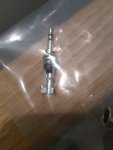Drivewire
Newbie
Greetings, all:
New here and learning. I've been trying to improve my SWL with my Sangean ATS-909 and since the reel antenna that came with it helps, I'd like to add a longer wire. Tried a few times but my solder skills are rough and my latest attempt failed entirely. Does anyone have suggestions on what gauge to use? I tried maybe 22 gauge/ 50 foot in the past but felt maybe the receiver could not handle the length. Currently I tried 18 gauge and maybe 65 foot but no luck at all. And it is properly mounted with insulators and what I thought was a good soldered lead in wire and the correct plug. Maybe there is a limit to the length?
Thanks for the ideas. When it works it does pick up some good distant signals.
Cheers.
New here and learning. I've been trying to improve my SWL with my Sangean ATS-909 and since the reel antenna that came with it helps, I'd like to add a longer wire. Tried a few times but my solder skills are rough and my latest attempt failed entirely. Does anyone have suggestions on what gauge to use? I tried maybe 22 gauge/ 50 foot in the past but felt maybe the receiver could not handle the length. Currently I tried 18 gauge and maybe 65 foot but no luck at all. And it is properly mounted with insulators and what I thought was a good soldered lead in wire and the correct plug. Maybe there is a limit to the length?
Thanks for the ideas. When it works it does pick up some good distant signals.
Cheers.


